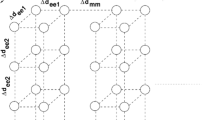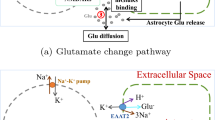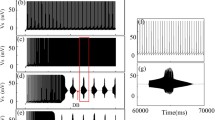Abstract
Recent experimental studies have shown that astrocytes respond to external stimuli with a transient increase of the intracellular calcium concentration or can exhibit self-sustained spontaneous activity. Both evoked and spontaneous astrocytic calcium oscillations are accompanied by exocytosis of glutamate caged in astrocytes leading to paroxysmal depolarization shifts (PDS) in neighboring neurons. Here, we present a simple mathematical model of the interaction between astrocytes and neurons that is able to numerically reproduce the experimental results concerning the initiation of the PDS. The timing of glutamate release from the astrocyte is studied by means of a combined modeling of a vesicle cycle and the dynamics of SNARE-proteins. The neuronal slow inward currents (SICs), induced by the astrocytic glutamate and leading to PDS, are modeled via the activation of presynaptic glutamate receptors. The dependence of the bidirectional communication between neurons and astrocytes on the concentration of glutamate transporters is analyzed, as well. Our numerical results are in line with experimental findings showing that astrocyte can induce synchronous PDSs in neighboring neurons, resulting in a transient synchronous spiking activity.
Similar content being viewed by others
References
Aguado F, Espinosa-Parrilla J, Carmona M and Soriano E (2002). Neuronal activity regulates correlated network properties of spontaneous calcium transients in astrocytes in situ. J Neurosci 22: 9430–9444
Angulo M, Kozlov A, Charpak S and Audinat E (2004). Glutamate released from glial cells synchronizes neuronal activity in the hippocampus. J Neurosci 24: 6920–6927
Anlauf E and Derouiche A (2004). Astrocytic exocytosis vesicles and glutamate: a high-resolution immunofluorescence study. Glia 49: 96–106
Araque A, Parpura V, Sanzgiri R and Haydon P (1998). Glutamate-dependent astrocyte modulation of synaptic transmission between cultured hippocampal neurons. Eur J Neurosci 10: 2129–2139
Araque A, Parpura V, Sanzgiri R and Haydon P (1999). Tripartite synapses: glia, the unacknowledged partner. Trends Neurosci 22: 208–215
Araque A, Li N, Doyle R and PG H (2000). Snare protein-dependent glutamate release from astrocytes. J Neurosci 20: 666–673
Attwell D, Barbour B and Szatkowski M (1993). Nonvesicular release of neurotransmitter. Neuron 11: 401–407
Bergles D and Jahr C (1998). Glial contribution to glutamate uptake at schaffer collateral-commisural synapses in hippocampus. J Neurosci 18: 293–298
Bergles D, Diamond J and Jahr C (1999). Clearance of glutamate inside the synapse and beyond. Curr Opin Neurobiol 9: 293–298
Bezzi P, Gundersen V, Galbete J, Seifert G, Steinhnser C, Pilati E and Volterra A (2004). Astrocytes contain a vesicular compartment that is competent for regulated exocytosis of glutamate. Nat Neurosci 7: 613–620
Bi G and Poo M (1998). Synaptic modifications in cultured hippocampal neurons: Dependence on spike timing, synaptic strength and postsynaptic cell type. J Neurosci 18: 10,464–10,472
Borghans J, Dupont G and Goldbeter A (1997). Complex intracellular calcium oscillations: A theoretical exploration of possible mechanisms. Biophys Chem 66: 25–41
Charles A (1998). Intercellular calcium waves in glia. Glia 24: 39–49
Chen X, Wang L, Zhou Y, Zheng L and Zhou Z (2005). Kiss-and-run glutamate secretion in cultured and freshly isolated rat hippocampal astrocytes. J Neurosci 25: 9236–9243
Coles J and Orkand R (1983). Modification of potassium movement through the retina of the drone (apis-mellifera-male) by glial uptake. J Physiol (London) 340: 157–174
Cornellbell A, Finkbeiner S, Cooper M and Smith S (1990). Glutamate induces calcium waves in cultured astrocytes: long-range glial signaling. Science 247: 470–473
Crippa D, Schenk U, Francolini M, Rosa P, Verderio C, Zonta M, Pozzan T, Matteoli M and Carmignoto G (2006). Synaptobrevin2-expressing vesicles in rat astrocytes: insights into molecular characterization, dynamics and exocytosis. J Physiol (London) 570: 567–582
Danbolt N (2001). Glutamate uptake. Prog Neurobiol 65: 1–105
Destexhe A, Mainen Z, Sejnowski T (1998) Kinetic models in synaptic transmission. In: Methods in neuronal modeling, 2nd edn. Cambridge University Press, Cambridge 1–25
Fellin T and Haydon P (2005). Do astrocytes contribute to excitation underlying seizures. Trend Mol Med 11: 530–533
Fellin T, Pascual O, Gobbo S, Pozzan T, Haydon P and Carmignoto G (2004). Neuronal synchrony mediated by astrocytic glutamate through activation of extrasynaptic nmda receptors. Neuron 43: 729–743
Fellin T, Gomez-Gonzalo M, Gobbo S, Carmignoto G and Haydon P (2006). Astrocytic glutamate is not necessary for the generation of epileptiform neuronal activity in hippocampal slices. J Neurosci 26: 9312–9322
Gersdorf Hv and Matthews G (1994). Dynamics of synaptic vesicle fusion and membrane retrieval in synaptic terminals. Nature 367: 735–739
Goldbeter A, Dupont G and Berridge M (1990). Minimal model for signal-induced ca2+ oscillations and for their frequency encoding through protein phosphorylation. Proc Natl Acad Sci USA 87: 1461–1465
Halassa M, Fellin T, Takano H, Dong J and Haydon P (2007). Synaptic islands defined by the territory of a single astrocyte. J Neurosci 27: 6473–6477
Haydon P (2001). Glia:listening and talking to the synapse. Nat Rev Neurosci 2: 185–193
Haydon P, Araque A (2002) Astrocytes as modulators of synaptic transmission. In: Volterra A, Magestretti PG, Haydon PG (eds) The tripartite synapse: glia in synaptic transmission vol. 4, pp 185–189
Heidelberger R, Heinemann C, Neher E and Matthews G (1994). Calcium dependence of the rate of exocytosis in a synaptic terminal. Nature 371: 513–515
Hertz L, Schousboe A, Boechler N, Mukerji S and Fedoroff S (1978). Kinetic characteristics of the glutamate uptake into normal astrocyte in cultures. Neurochem Res 3: 3–14
Holmes W (1995). Modeling the effect of glutamate diffusion and uptake on nmda and non-nmda receptor saturation. Biophys J 69: 1734–1747
Houart G, Dupont G and Goldbeter A (1999). Bursting, chaos and birythmicity originating from self-modulation of ip3 signal in a model for intracellular ca2+ oscillations. Bull Math Biol 61: 507–530
Jourdain P, Bergersen L, Bhaukaurally K, Bezzi P, Santello M, Domercq M, Matute C, Tonello F, Gundersen V and Volterra A (2007). Glutamate exocytosis from astrocytes controls synaptic strength. Nat Neurosci 10: 331–339
Kang J, Jiang L, Goldman S and Nedergaard M (1998). Astrocyte-mediated potentiation of inhibitory synaptic transmission. Nat Neurosci 1: 683–692
Kang N, Xu J, Xu Q, Nedergaard M and Kang J (2005). Astrocytic glutamate release-induced transient depolarization and epileptiform discharges in hippocampal ca1 pyramidal neurons. J Neurophysiol 94: 4121–4130
Keizer J and De Young G (1992). Two roles for ca2+ in agonist stimulated ca2+ oscillations. Biophys J 61: 649–660
Kleinle J, Vogt K, Luscher H, Muller L, Senn W, Wyler K and Streit J (1996). Transmitter concentration profiles in the synaptic cleft: An analytical model of release and diffusion. Biophys J 71: 2413–2426
Kreft M, Stenovec M, Rupnik M, Grilc S, Kran M, Potokar M, Pangri T and Haydon PRZ (2004). Properties of ca2+-dependent exocytosis in cultured astrocytes. Glia 46: 437–445
Lee C, Mannaioni G, Yuan H, Woo D, Gingrich M and Traynelis S (2007). Astrocytic control of synaptic nmda receptors. J Physiol (London) 581: 1057–1081
Lehre K and Rusakov D (2002). Asymmetry of glia near central synapses favors presynaptically directed glutamate escape. Biophys J 83: 125–134
Markram H, Helm P and Sakmann B (1995). Dendritic calcium transients evoked by single back-propagating action potentials in rat-neocortical pyramidal neurons. J Physiol (London) 485: 1–20
Markram H, Lubke J, Frotscher M and Sakmann B (1997). Regulation of synaptic efficacy by coincidence of postsynaptic aps and epsps. Science 275: 213–215
Meyer T and Stryer L (1988). Molecular model for receptor-stimulated calcium spiking. Proc Natl Acad Sci USA 85: 5051–5055
Montana V, Ni Y, Sunjara V, Hua X and Parpura V (2004). Vesicular glutamate transporter-dependent glutamate release from astrocytes. J Neurosci 24: 2633–2642
Montana V, Malarkey E, Verderio C, Matteoli M and Parpura V (2006). Vesicular transmitter release from astrocytes. Glia 54: 700–715
Muyderman H, Angehagen M, Sandberg M, Bjorklund U, Olsson T, Hansson E and Nilsson M (2001). alpha(1)-adrenergic modulation of metabotropic glutamate receptor-induced calcium oscillations and glutamate release in astrocytes. J Biol Chem 276: 46,504–46,514
Nadkarni S and Jung P (2004). Dressed neurons: modeling neural-glial interactions. Phys Biol 1: 35–41
Nadkarni S and Jung P (2005). Synaptic inhibition and pathologic hyperexcitability through enhanced neuron-astrocyte interaction: a modeling study. J Inegr Neurosci 4: 207–226
Nadkarni S and Jung P (2007). Modeling synaptic transmission of the tripartite synapse. Phys Biol 4: 1–9
Neher E (1998). Vesicle pools and ca2+ microdomains: new tools for understanding their roles in neurotransmitter release. Neuron 20: 389–399
Nett W, Oloff S and McCarthy K (2002). Hippocampal astrocytes in situ exhibit calcium oscillations that occur independent of neuronal activity. J Neurophysiol 87: 528–537
Newman E (2005). Glia and synaptic transmission. In: Neuroglia, eds Kettenmann H and Ransom 10: 101–105
Newman E and Zahs K (1997). Calcium waves in retinal glial cells. Science 275: 844–847
Oliet S, Piet R and Poulain D (2001). Control of glutamate clearance and synaptic efficacy by glial coverage of neurons. Science 292: 923–926
Parpura V and Haydon P (2000). Physiological astrocytic calcium levels stimulate glutamate release to modulate adjacent neurons. Proc Natl Acad Sci USA 97: 8629–8634
Parpura V, Basarsky T, Liu F, Jeftinija K, Jeftinija S and Haydon P (1994). Glutamate-mediated astrocyte neuron signaling. Nature 369: 744–747
Parri H, Gould T and Crunelli V (2001). Spontaneous astrocytic ca2+ oscillations in situ drive nmdar-mediated neuronal excitation. Nat Neurosci 4: 803–812
Pinsky P and Rinzel J (1994). Intrinsic and network rhythmogenesis in a reduced traub model for ca3 neurons. J Comp Neurosci 1: 39–43
Postnov D, Ryazanova L and Sosnovtseva O (2007). Functional modeling of neuralGÇôglial interaction. Biosystems 89: 84–91
Retting J and Neher E (2002). Emerging roles of presynaptic proteins in ca2+ triggered exocytosis. Science 298: 781–785
Robitaille R (1998). Modulation of synaptic efficacy and synaptic depression by glial cells at the frog neuromuscular junction. Neuron 21: 847–855
Rusakov D (2001). The role of perisynaptic glial sheaths in glutamate spillover and extracellular ca2+ depletion. Biophys J 81: 1947–1959
Rusakov D and Kullmann D (1998). Extrasynaptic glutamate diffusion in the hippocampus: Ultrastructural constraints, uptake and receptor activation. J Neurosci 18: 3158–3170
Rusakov D, Kullmann D and Stewart M (1999). Hippocampal synapses: do they talk to their neighbours?. Trends Neurosci 22: 382–388
Schneggenburger R and Neher E (2000). Intracellular calcium dependence of transmitter release rates at a fast central synapse. Nature 406: 889–893
Soellner C, Bennett M, Whiteheart S, Scheller R and Rothman J (1993). A protein assembly-disassembly pathway in vitro that may correspond to sequential steps of synaptic vesicle docking, activation and fusion. Cell 75: 409–418
Suedhof T (2004). The synaptic vesicle cycle. Annu Rev Neurosci 27: 509–547
Suzuki Y, Moriyoshi E, Tsuchiya D and Jingami H (2004). Negative cooperativity of glutamate binding in the dimeric metabotropic glutamate receptor. J Biol Chem 279: 35,526–35,534
Tian G, Azmi H, Takano T, Xu Q, Peng W, Lin J, Oberheim N, Lou N, Wang X, Zielke H, Kang J and Nedergaard M (2005). An astrocytic basis of epilepsy. Nat Med 11: 973–981
Volman V, Ben-Jacob E and Levine H (2007). The astrocyte as a gatekeeper of synaptic information transfer. Neural Comp 19: 303–326
Volterra A and Meldolesi J (2005). Astrocytes, from brain glue to communication elements: The revolution continues. Nat Rev Neurosci 6: 626–640
Wang X (1998). Calcium coding and adaptive temporal computation in cortical pyramidal neurons. J Neurophysiol 79: 1549–1566
Wang X, Lou N, Xu Q, Tian G, Peng W, Han X, Kang J, Takano T and Nedergaard M (2006). Astrocytic ca2+ signaling evoked by sensory stimulation in vivo. Nat Neurosci 9: 816–823
Zhang Q, Fukuda M, Van Bockstaele E, Pascual O and Haydon P (2004). Synaptotagmin iv regulates glial glutamate release. Proc Natl Acad Sci USA 101: 9441–9446
Author information
Authors and Affiliations
Corresponding author
Rights and permissions
About this article
Cite this article
Silchenko, A.N., Tass, P.A. Computational modeling of paroxysmal depolarization shifts in neurons induced by the glutamate release from astrocytes. Biol Cybern 98, 61–74 (2008). https://doi.org/10.1007/s00422-007-0196-7
Received:
Accepted:
Published:
Issue Date:
DOI: https://doi.org/10.1007/s00422-007-0196-7




